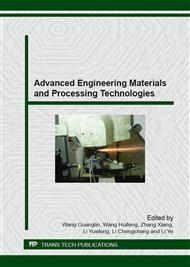p.187
p.194
p.200
p.206
p.213
p.218
p.224
p.231
p.237
Study the Influence of Surface Treatment Technology to AZ31 Property Change
Abstract:
Magnesium alloy which is one of the least light density (about1.7g/cm3) composites material on the ground for trade business, this material has better strength ratio of room temperature, high strength and rigidity, with good vibration attenuation, better damping, and good heat conduction,resistant radiation, don’t produce spark when friction, good ductility, better cutting machine and formed possibility, may be welded, adhesives, and have good chemical stability to Alkali, kerosene, gasoline, mineral oil and dry atmosphere, With no magnetic and electromagnetic shielding properties, Magnesium alloy products easy to recycle and no pollution to environment etc. Known as in twenty-first century the "green engineering materials”, In order to improve the use range of alloy,it need for improved performance of AZ31 magnesium alloy, AZ31 magnesium alloy surface modification technology to solve the main problems is to reduce the cost and environmental issues of a single technology, There is a wide prospect for the application of compound modification.
Info:
Periodical:
Pages:
213-217
Citation:
Online since:
October 2015
Authors:
Keywords:
Price:
Сopyright:
© 2016 Trans Tech Publications Ltd. All Rights Reserved
Share:
Citation:


